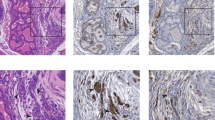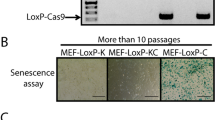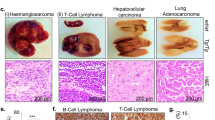Abstract
The dual Ser/Thr kinase MKK4 and its downstream targets JNK and p38 regulate critical cellular functions during embryogenesis and development. MKK4 has been identified as a putative tumor-suppressor gene in human solid tumors of breast, prostate and pancreas. To clarify the mechanisms underlying the transforming potential of molecular defects targeting MKK4, we have generated totipotent embryonic stem (ES) cells expressing the dominant-negative mutant DN-MKK4Ala, S257A/T261A. Stably transfected DN-MKK4-ES cells exhibit a transformed fibroblast-like morphology, reduced proliferation rate, were no more submitted to cell contact inhibition, were growing in soft agar, and were much more tumorigenic than parental ES cells in athymic nude mice. These phenotypic changes: (i) are consistent with the protection of DN-MKK4-transfected ES cells from spontaneous, cell density-dependent, and stress-induced apoptosis (DAPI staining and poly (ADP-ribose) polymerase (PARP) cleavage) and (ii) correlated with alterations in JNK, p38, and Erk-1/-2 MAPK/SAPK signaling. Taken together, our data provide a new mechanism linking the MKK4 signaling pathways to cancer progression and identify MKK4 as a tumor-suppressor gene implicated in several transforming functions.
This is a preview of subscription content, access via your institution
Access options
Subscribe to this journal
Receive 50 print issues and online access
$259.00 per year
only $5.18 per issue
Buy this article
- Purchase on Springer Link
- Instant access to full article PDF
Prices may be subject to local taxes which are calculated during checkout





Similar content being viewed by others
References
Allen M, Svensson L, Roach M, Hambor J, McNeish J and Gabel CA . (2000). J. Exp. Med., 191, 859–870.
Andrews NC and Faller DV . (1991). Nucleic Acids Res., 19, 2499.
Atfi A, Djelloul S, Chastre E, Davis R and Gespach C . (1997). J. Biol. Chem., 272, 1429–1432.
Beddington RS and Robertson EJ . (1989). Development, 105, 733–737.
Behrens A, Sibilia M and Wagner EF . (1999). Nat. Genet., 21, 326–329.
Brunet A, Pages G and Pouyssegur J . (1994). Oncogene, 9, 3379–3387.
Burdon T, Stracey C, Chambers I, Nichols J and Smith A . (1999). Dev. Biol., 210, 30–43.
Cardone MH, Salvesen GS, Widmann C, Johnson G and Frisch SM . (1997). Cell, 90, 315–323.
Day ML, Foster RG, Day KC, Zhao X, Humphrey P, Swanson P, Postigo AA, Zhang SH and Dean DC . (1997). J. Biol. Chem., 272, 8125–8128.
Draper JS, Smith K, Gokhale P, Moore HD, Maltby E, Johnson J, Meisner L, Zwaka TP, Thomson JA and Andrews PW . (2004). Nature Biotech., 22, 53–54.
Duriez PJ and Shah GM . (1997). Biochem. Cell Biol., 75, 337–349.
Evans MJ and Kaufman MH . (1981). Nature, 292, 154–156.
Ferrigno O, Lallemand F, Verrecchia F, L'Hoste S, Camonis J, Atfi A and Mauviel A . (2002). Oncogene, 21, 4879–4884.
Ganiatsas S, Kwee L, Fujiwara Y, Perkins A, Ikeda T, Labow MA and Zon LI . (1998). Proc. Natl. Acad. Sci. USA, 95, 6881–6886.
Glise B, Bourbon H and Noselli S . (1995). Cell, 83, 451–461.
Hilberg F, Aguzzi A, Howells N and Wagner EF . (1993). Nature, 365, 179–181.
Ho DT, Bardwell AJ, Abdollahi M and Bardwell L . (2003). J. Biol. Chem., 278, 32662–32672.
Jirmanova L, Afanassieff M, Gobert-Gosse S, Markossian S and Savatier P . (2002). Oncogene, 21, 5515–5528.
Kieran MW, Katz S, Vail B, Zon LI and Mayer BJ . (1999). Oncogene, 18, 6647–6657.
Labarca C and Paigen K . (1980). Anal. Biochem., 102, 344–352.
Lee JK, Hwang WS, Lee YD and Han PL . (1999). Brain Res. Mol. Brain Res., 66, 133–140.
Lin A, Minden A, Martinetto H, Claret FX, Lange-Carter C, Mercurio F, Johnson GL and Karin M . (1995). Science, 268, 286–290.
Manning AM and Davis RJ . (2003). Nat. Rev. Drug Discov., 2, 554–565.
Markowitz SD, Dawson DM, Willis J and Willson JK . (2002). Cancer Cell, 1, 233–236.
Marshall CJ . (1995). Cell, 80, 179–185.
Martin GR . (1981). Proc. Natl. Acad. Sci. USA, 78, 7634–7638.
McPherson JP and Goldenberg GJ . (1998). Cancer Res., 58, 4519–4524.
Minden A, Lin A, Smeal T, Derijard B, Cobb M, Davis R and Karin M . (1994). Mol. Cell. Biol., 14, 6683–6688.
Moelling K, Schad K, Bosse M, Zimmermann S and Schweneker M . (2002). J. Biol. Chem., 277, 31099–31106.
Nakano T . (1995). Semin. Immunol., 7, 197–203.
Nishina H, Fischer KD, Radvanyi L, Shahinian A, Hakem R, Rubie EA, Bernstein A, Mak TW, Woodgett JR and Penninger JM . (1997). Nature, 385, 350–353.
Nishina H, Vaz C, Billia P, Nghiem M, Sasaki T, De la Pompa JL, Furlonger K, Paige C, Hui C, Fischer KD, Kishimoto H, Iwatsubo T, Katada T, Woodgett JR and Penninger JM . (1999). Development, 126, 505–516.
Okabe S, Forsberg-Nilsson K, Spiro AC, Segal M and McKay RD . (1996). Mech. Dev., 59, 89–102.
Prunier C, Pessah M, Ferrand N, Seo SR, Howe P and Atfi A . (2003). J. Biol. Chem., 278, 26249–26257.
Ramirez-Solis R, Davis AC and Bradley A . (1993). Methods Enzymol., 225, 855–878.
Rao CV, Wang CX, Simi B, Lubet R, Kelloff G, Steele V and Reddy BS . (1997). Cancer Res., 57, 3717–3722.
Rivat C, Le Floch N, Sabbah M, Teyrol I, Redeuilh G, Bruyneel E, Mareel M, Matrisian LM, Crawford HC, Gespach C and Attoub S . (2003). FASEB J., 17, 1721–1723.
Robertson EJ . (1987). Teratocarcinomas and Embryonic Stem Cells: A Practical Approach, Robertson EJ (ed) IRL Press: Washington, DC, pp. 71–112.
Roulston A, Reinhard C, Amiri P and Williams LT . (1998). J. Biol. Chem., 273, 10232–10239.
Sambrook J, Fritsch EF and Maniatis T . (1989). Molecular Cloning: A Laboratory Manual. Cold Spring Harbor Laboratory Press: Cold Spring Harbor, NY.
Schultz RM . (2003). Prog. Drug Res., 60, 59–92.
Shen YH, Godlewski J, Zhu J, Sathyanarayana P, Leaner V, Birrer MJ, Rana A and Tzivion G . (2003). J. Biol. Chem., 278, 26715–26721.
Skov S, Klausen P and Claesson MH . (1997). J. Cell. Biol., 139, 1523–1531.
Sporn MB, Roberts AB, Wakefield LM and Assoian RK . (1986). Science, 233, 532–534.
Su B and Karin M . (1996). Curr. Opin. Immunol., 8, 402–411.
Su GH, Hilgers W, Shekher MC, Tang DJ, Yeo CJ, Hruban RH and Kern SE . (1998). Cancer Res., 58, 2339–2342.
Teng DH, Perry WL, Hogan JK, Baumgard M, Bell R, Berry S, Davis T, Frank D, Frye C, Hattier T, Hu R, Jammulapati S, Janecki T, Leavitt A, Mitchell JT, Pero R, Sexton D, Schroeder M, Su PH, Swedlund B, Kyriakis JM, Avruch J, Bartel P, Wong AK and Tavtigian SV . (1997). Cancer Res., 57, 4177–4182.
Treisman R . (1996). Curr. Opin. Cell Biol., 8, 205–215.
Ware LM and Axelrad AA . (1972). Virology, 50, 339–348.
Whitmarsh AJ and Davis RJ . (1996). J. Mol. Med., 74, 589–607.
Whitmarsh AJ, Shore P, Sharrocks AD and Davis RJ . (1995). Science, 269, 403–407.
Wilson DJ, Fortner KA, Lynch DH, Mattingly RR, Macara IG, Posada JA and Budd RC . (1996). Eur. J. Immunol., 26, 989–994.
Wisdom R, Johnson RS and Moore C . (1999). EMBO J., 18, 188–197.
Wobus AM, Kaomei G, Shan J, Wellner MC, Rohwedel J, Ji G, Fleischmann B, Katus HA, Hescheler J and Franz WM . (1997). J. Mol. Cell Cardiol., 29, 1525–1539.
Yamada SD, Hickson JA, Hrobowski Y, Vander Griend DJ, Benson D, Montag A, Karrison T, Huo D, Rutgers J, Adams S and Rinker-Schaeffer CW . (2002). Cancer Res., 62, 6717–6723.
Yang D, Tournier C, Wysk M, Lu HT, Xu J, Davis RJ and Flavell RA . (1997). Proc. Natl. Acad. Sci. USA, 94, 3004–3009.
Yang DD, Kuan CY, Whitmarsh AJ, Rincon M, Zheng TS, Davis RJ, Rakic P and Flavell RA . (1997). Nature, 389, 865–870.
Yang X, Khosravi-Far R, Chang HY and Baltimore D . (1997). Cell, 89, 1067–1076.
Yoshida BA, Dubauskas Z, Chekmareva MA, Christiano TR, Stadler WM and Rinker-Schaeffer CW . (1999). Cancer Res., 59, 5483–5487.
Young MR, Yang HS and Colburn NH . (2003). Trends Mol. Med., 9, 36–41.
Acknowledgements
We are indebted to Dr Allan Bradley for the AB-1 mouse ES cells, to Dr Benoit Derijard for the gift of DN-MKK4 expression vector, are grateful to Drs Fanny Bleiberg-Daniel and Ghislaine Schweizer-Groyer for critical reading of the manuscript.
Author information
Authors and Affiliations
Corresponding author
Rights and permissions
About this article
Cite this article
Cazillis, M., Bringuier, AF., Delautier, D. et al. Disruption of MKK4 signaling reveals its tumor-suppressor role in embryonic stem cells. Oncogene 23, 4735–4744 (2004). https://doi.org/10.1038/sj.onc.1207619
Received:
Revised:
Accepted:
Published:
Issue Date:
DOI: https://doi.org/10.1038/sj.onc.1207619
Keywords
This article is cited by
-
c-Jun N-terminal kinase is activated in non-small-cell lung cancer and promotes neoplastic transformation in human bronchial epithelial cells
Oncogene (2007)
-
Role of mitogen-activated protein kinase kinase 4 in cancer
Oncogene (2007)
-
ERK regulation upon contact inhibition in fibroblasts
Molecular and Cellular Biochemistry (2006)



